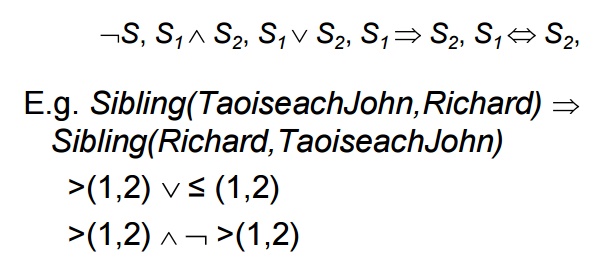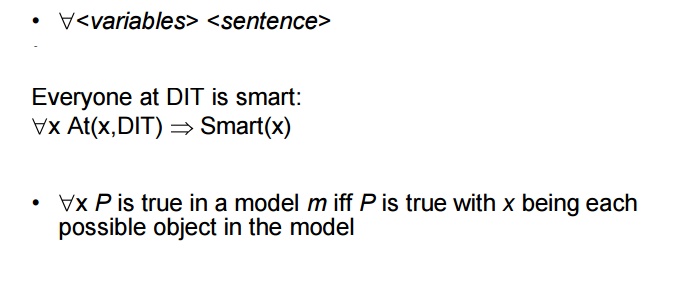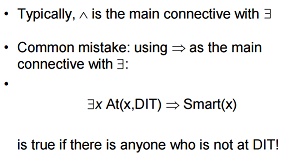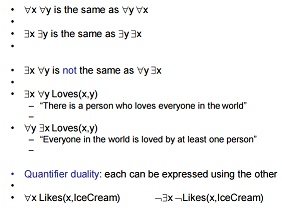Chapter: Artificial Intelligence(AI) : Representation of Knowledge
Predicate Calculus
Predicate Calculus
First-order logic
Whereas propositional logic assumes the world
contains facts,
first-order logic (like natural language)
assumes the world contains
Objects: people, houses, numbers, colors, baseball games, wars, …
Relations: red, round, prime, brother of, bigger than, part of, comes between, …
Syntax of FOL: Basic elements
• Constants TaoiseachJohn, 2, DIT,...
• Predicates Brother, >,...
• Functions Sqrt, LeftLegOf,...
• Variables x, y, a, b,...
• Connectives , 
• Equality =
• Quantifiers , 
Atomic sentences
Atomic sentence = predicate
(term1,...,termn)
or term1
= term2
Term = function
(term1,...,termn)
or constant
or variable
E.g., Brother(TaoiseachJohn,RichardTheLionheart)
> (Length(LeftLegOf(Richard)),
Length(LeftLegOf(TaoiseachJohn)))
Complex sentences
Complex sentences are made from atomic sentences using connectives

Truth in first-order logic
Sentences are true with respect to a model and an interpretation
Model contains objects (domain
elements) and relations among them
Interpretation specifies referents for
constant
symbols → objects
predicate
symbols → relations
function
symbols → functional
relations
An atomic sentence predicate(term1,...,termn) is true iff the objects referred to by term1,...,termn
are in the relation
referred to by predicate
Universal
quantification

Roughly speaTaoiseach, equivalent to the
conjunction of instantiations of P
At(TaoiseachJohn,DIT) -- > Smart(TaoiseachJohn)
At(Richard,DIT) -- > Smart(Richard)
At(DIT,DIT)
-- > Smart(DIT)
A common mistake to avoid

means “Everyone is at DIT and everyone is smart”
Existential
quantification

Roughly speaTaoiseach, equivalent to the
disjunction of instantiations of P
At(TaoiseachJohn,DIT) -- > Smart(TaoiseachJohn)
At(Richard,DIT) --
> Smart(Richard)
At(DIT,DIT) --
> Smart(DIT)
Another
common mistake to avoid

Properties
of quantifiers

Equality
term1
= term2 is true
under a given interpretation if and
only if term1 and term2 refer to the same
object
E.g., definition of Sibling in terms of Parent:

Using
FOL
The kinship domain:
Brothers are siblings

One's mother is one's female parent

“Sibling” is symmetric
Knowledge engineering in FOL
·
Identify
the task
·
Assemble
the relevant knowledge
·
Decide on
a vocabulary of predicates, functions, and constants
·
Encode
general knowledge about the domain
·
Encode a
description of the specific problem instance
·
Pose
queries to the inference procedure and get answers
·
Debug the
knowledge base
Summary
First-order
logic:
objects and relations are semantic primitives
syntax: constants, functions, predicates,
equality, quantifiers
Semantics
for Predicate Calculus
An interpretation over D is an assignment of the
entities of D to each of the constant, variable, predicate and function symbols
of a predicate calculus expression such that:
1: Each constant is assigned an element of D
2: Each variable is assigned a non-empty subset
of D;(these are the allowable substitutions for that variable)
3: Each predicate of arity n is defined on n
arguments from D and defines a mapping from Dn into {T,F}
4: Each function of arity n is defined on n
arguments from D and defines a mapping from Dn into D
The meaning
of an expression
Given an interpretation, the meaning of an
expression is a truth value assignment over the interpretation.
Truth
Value of Predicate Calculus expressions
Assume an expression E and an interpretation I
for E over a non empty domain D. The truth value for E is determined by:
The value of a constant is the element of D
assigned to by I
The value of a variable is the set of elements
assigned to it by I
More
truth values
The value of a function expression is that
element of D obtained by evaluating the function for the argument values
assigned by the interpretation
The value of the truth symbol “true” is T
The value of the symbol “false” is F
The value of an atomic sentence is either T or F
as determined by the interpretation I
Similarity
with Propositional logic truth values
The value of the negation of a sentence is F if
the value of the sentence is T and F otherwise
The values for conjunction, disjunction
,implication and equivalence are analogous to their propositional logic
counterparts
Universal
Quantifier
The value for

Is T if S is T for all assignments to X under I,
and F otherwise
Existential
Quantifier
The value for

Is T if S is T for any assignment to X under I,
and F otherwise
Some
Definitions
A predicate calculus expressions S1 is satisfied.
Definition
If there exists an Interpretation I and a variable assignment under I which
returns a value T for S1 then S1 is said to be satisfied under I.
S is Satisfiable if there exists an
interpretation and variable assignment that satisfies it: Otherwise it is
unsatisfiable
A set of predicate calculus expressions S is satisfied.
Definition
For any interpretation I and variable assignment where a value T is returned for every element
in S the the set S is said to be satisfied,
A set of expressions is satisfiable if and only
if there exist an intrepretation and variable assignment that satisfy every
element
If a set of expressions is not satisfiable, it is
said to be inconsistent
If S has a value T for all possible
interpretations , it is said to be valid
A predicate
calculus expressions S1 is satisfied.
Definition
If there exists an Interpretation I and a
variable
assignment under I which returns a value T for
S1 then S1 is
said to be satisfied under I.
A set of predicate calculus expressions S is satisfied.
Definition
For any interpretation I and variable assignment
where a value T is returned for every element in S the the set
S is said to be satisfied,
An inference rule is complete.
Definition
If all predicate calculus expressions X that
logically
follow from a set of expressions, S can be
produced using the
inference rule , then the inference rule is said
to be complete.
A predicate calculus expression X logically follows from a set S of predicate calculus expressions .
For any interpretation I and variable assignment
where S is satisfied, if X is also satisfied under the same interpretation and
variable assignment then X logically follows from S.
Logically follows is sometimes called entailment
Soundness
An inference rule is sound.
If all predicate calculus expressions X produced
using the inference rule from a set of expressions, S logically follow from S
then the inference rule is said to be sound.
Completeness
An inference Rule is complete if given a set S
of predicate calculus expressions, it can infer every expression that logically
follows from S
Related Topics